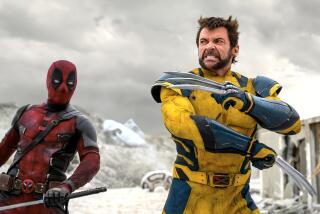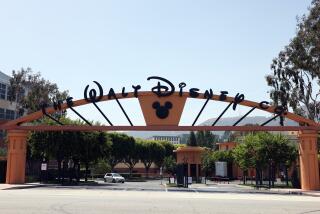Behind the Disney Magic
- Share via
When top Hollywood lobbyist Jack Valenti took the stage at a recent awards banquet, he lavished praise on the man of the hour -- Michael Eisner -- and his 19 years at the helm of Walt Disney Co.
To make his point, Valenti told the crowd that an investor who bought $10,000 of Disney stock when Eisner took the helm in 1984 would be sitting on more than $220,000 today.
To be sure, Disney’s return to shareholders over the last 20 years has been spectacular, far outpacing the average blue-chip stock.
The trouble is, few investors hold on to their shares for that long. And though the long-term return has been stellar, it masks the much weaker performance of the stock over the last five years, notwithstanding a rally over the last 16 months that has encouraged many Disney investors.
That’s the argument two former board members are taking to Wall Street in a campaign to ultimately unseat Eisner. Roy E. Disney, the second-largest individual shareholder in Disney and the nephew of the company’s co-founder, quit the board two weeks ago. He was followed by his ally and fellow board member Stanley Gold.
In their resignations, both men called attention to the company’s slide in profit and its once-golden stock price. In one interview, Roy Disney quipped that shareholders would have been better off putting their money in a savings account over the last seven years.
Over the last decade, Disney’s return to shareholders, including dividends, has been less than half that of the average blue-chip stock. Investors who jumped in five years ago have fared even worse. The return to investors fell 28% during that period, far steeper than the 3% slide for the Standard & Poor’s 500 index.
During the same period, Viacom Inc.’s return to shareholders rose 20%, and News Corp.’s owners saw a 27% gain. Two other high-profile media giants -- Time Warner Inc. and Vivendi Universal -- have sad returns, but that’s little consolation to Disney’s investors who had grown accustomed to years of double-digit growth rates.
“It has underperformed,” said Jessica Reif Cohen, a senior media analyst at Merrill Lynch, which has a neutral rating on the Disney stock. “They’ve had problems in many divisions.”
Not surprisingly, attitudes toward Disney stock vary depending on when an investor bought it.
“If you bought Disney at the top and you look at today’s price, you’re not happy with its performance,” said Jeffrey Logsdon, a media analyst with Harris Nesbitt Gerard. “This stock has been much more of a trading vehicle in the last five years than it has been a buy-and-hold stock.”
But Logsdon and other analysts say they are nevertheless encouraged by the company’s improved finances -- and share price. Disney shares have risen more than 60% since August 2002 when the stock fell to an eight-year low in the wake of a dismal earnings forecast and shakiness in the company’s credit ratings. In fact, as the company has noted, Disney shares are up 40% this year, nearly double the gains of both the Dow and the S&P; 500.
That’s the principal reason investors have reacted coolly to the boardroom resignations two weeks ago.
After falling 6% in the first week after the resignations, Disney shares have steadily climbed back, closing Friday at $22.82, up 17 cents, in New York Stock Exchange trading.
“At the end of the day what’s relevant is the forward outlook,” said Larry Haverty, money manager with State Street Research & Management Co., which is a Disney investor. “This year is going to be great.”
Disney, whose film studio set an industry record this year with more than $3 billion in worldwide box-office receipts, has been touting the turnaround story to Wall Street.
At an investor conference Wednesday, Disney Chief Financial Officer Tom Staggs reaffirmed an earlier forecast that Disney would post at least a 30% gain in earnings per share in 2004, up from 65 cents in 2003. He cited improvements at ABC, strong DVD sales and a gradual recovery in theme park business. He also said that attendance at Disney’s U.S. theme parks was up 11% over last year.
“Our company is strong and getting stronger, and the general economy is improving as well,” Staggs said.
Certainly, part of the stock downturn over the last five years has been because of recession and geopolitical events beyond Disney’s control. Among media companies, Disney is the most susceptible to economic swings because of its heavy reliance on tourism and television advertising -- sectors that have been hit hard by recession and the dramatic falloff in travel since the Sept. 11 terrorist attacks.
But the stock decline also has mirrored investor concerns about long-term problems within the company, analysts say.
With the exception of a strong rally in 2000 and the more recent upturn, Disney’s stock price began its downward spiral in 1998, when it was trading at more than $40 a share.
The downturn coincided with a falloff in the company’s earnings, which saw a decline in video sales and merchandise revenue, a slide in ratings at the ABC television network and the spotty performance of its once-mighty animation division.
“Their success in animation in the last few years has unquestionably come from Pixar,” Cohen said, noting that the future of that relationship was uncertain. Disney and Pixar Animation Studios have been in testy contract negotiations over the future of their lucrative partnership, which produced such computer-animated hits as “Finding Nemo” and the “Toy Story” films. Pixar wants a much bigger cut of the profit that is currently split 50-50 between the two companies. Disney also gets an additional 12.5% distribution fee.
Disney’s frayed relations with Pixar was among the criticisms that Roy Disney leveled against Eisner.
The criticisms, however, have yet to gain much traction among major investors.
Although institutional investors such as mutual fund giants Vanguard Group and Fidelity Management have held positions in Disney for years, they shrink and expand their holdings based on the company’s outlook. The mutual funds that are Disney’s biggest shareholders typically trade in and out.
Many cut their losses after Disney’s largest shareholder, the Bass family of Texas, sold two-thirds of its shares to raise cash after the stock market collapse in the wake of the Sept. 11 terrorist attacks.
“Lots of big investors got out when the stock hit $25 and got back in at $14 or $15 after the Basses liquidated their shares,” said independent media analyst Christopher Dixon.
The Bass sale was a setback to Disney and Eisner in particular because the family, along with Roy Disney and Gold, had been part of a boardroom coup in 1984 that recruited Eisner to the company from Paramount Pictures.
The Basses also were the second high-profile investor to unload Disney shares. Investor Warren E. Buffett divested most of his Disney holdings in 1999 and 2000 without saying why.
Though major investors have been able to hedge their losses, many individual investors have not been so lucky.
“The ones who got hurt,” Dixon said, “are the buy-and-hold investors who bought the stock for their 3-year-old granddaughter.”
*
Times staff writer Kathy Kristof contributed to this report.
More to Read
The biggest entertainment stories
Get our big stories about Hollywood, film, television, music, arts, culture and more right in your inbox as soon as they publish.
You may occasionally receive promotional content from the Los Angeles Times.











